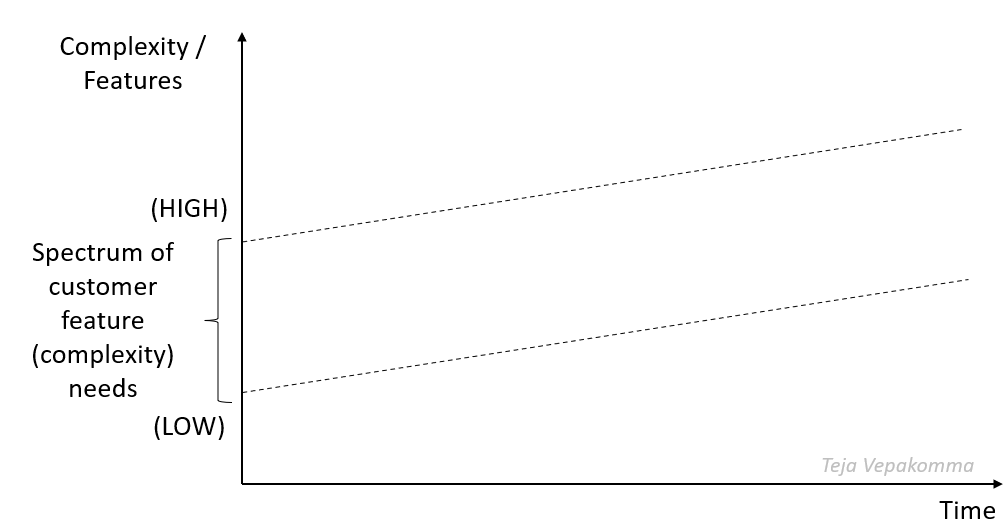When to stop adding features to your Product
Understanding Product Complexity Lifecycle is the key to avoid getting disrupted by newer, simpler products
Product teams love adding new features. It feels tangible and productive. There’s something addictive about shipping features that it is hard to make a case for slowing down feature development.
But, adding features also means increasing the complexity of the product. It is very important to keep the customer and market need in mind while deciding when to accelerate and decelerate feature development.
Customer Needs Spectrum
Customers have a spectrum of needs. In the case of B2B SAAS products for example, at the lower end of the spectrum are consumers and small businesses who demand a certain amount of features (and therefore a certain product complexity) and at the higher end of the spectrum are the large Enterprise customers whose demand for new and bespoke features never seems to end.
Customers’ feature needs (and therefore product complexity demanded) increase steadily over time.
Product Complexity Lifecycle
To meet this customer demand, the product team develops new features rapidly, increasing the product complexity as an S-curve.
Why do product feature additions increase like an S-curve? Most products take some time to gain momentum in feature development, then enter growth phase (the steep part of the ‘S’) and finally enter the maturity phase (the fag end of the S-curve to the top-right).
Disruption Zone
Product feature additions often overshoot the needs of most customers, creating a “Disruption Risk” area (see figure below). This happens when the product enters maturity phase. Why does this happen? Enterprise customers are always demanding bespoke features. Also, customers in each segment or industry need a different set of bespoke features. This often puts pressure on the product team to deliver many different bespoke features that results in high product complexity (therefore low usability) for new customers.
This sets the stage for a new disrupting product to enter the market with a simpler solution (often using new technology or business model).
For example, Tally has emerged as a competitor to the popular Forms product Typeform with a powerful free version (new business model) and simplicity as key differentiator.
So, how can founders and product leaders ensure that their product doesn’t overshoot customers’ need and become too complex (as a result of adding too many features)? The answer lies in course correcting from the “normal evolution path” to following the “Complexity Horizon” path (see figure below).
Avoiding Disruption
Product leaders need to deliberately course-correct to slow down new feature development and instead focus on improving user experience and optimizing growth. This need to happen at the point (Y) as shown in the figure above.
So, how do product leaders know when to step off the accelerator pedal and shift gears away from feature development? In my product consulting practice, I have found the following metric helpful:
New Feature usage as % of Product MAU drops
Let’s say you released a new feature and it was used by 3% of your Monthly Active Users in the last month. Now, let’s say that out of all the features released in the year, the average usage of the features as a % of MAU is 3%.
If you plot the average usage of features released each year, over the past several years, and you notice the usage of new features as % of MAU that year steadily dropping (as shown in the figure below), it is a sure sign that adding new features is producing diminishing returns for users, while continuing to increase product complexity.

Instead of MAU, one can use WAU or DAU over the appropriate time period as per your users’ typical product usage behavior. The important thing is to observe if the new features are showing a clear trend of diminishing usage over time or not.
If this is the case, Product leaders need to intervene to slow down feature development and instead allocate more resources towards improving user experience, engagement, feature discovery and reducing complexity. This is akin to moving along the Complexity Horizon as shown in Figure 4.
Managing high product complexity
What if the product has already overshot the complexity horizon and is in the disruption zone? Most companies find their products in this state. The best thing to do in this case is to invest in a new product which is a simpler version of the existing product using the latest business models and tech stack. This is what Adobe has done with the new Rush product which is much similar compared to the Premier Pro product which is a lot more complex.
In addition to launching a new simpler product with modern tech stack and business model, Adobe also invested in improving the onboarding experience of Premier Pro for new users.
This dual approach of improving onboarding for existing product and introducing a new product to avoid competitors disrupting you, can be a good strategy in this case.
About the Author
Teja Vepakomma is a Product Strategy and Growth consultant to companies. He has many years of experience working in Product Management leadership roles in Global SAAS companies. He’s currently based in Bangalore, India.





